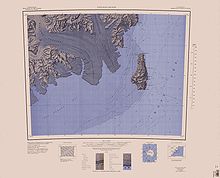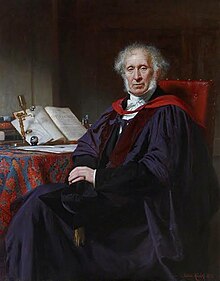Skelton Glacier is a large glacier flowing from the polar plateau into the Ross Ice Shelf at Skelton Inlet on the Hillary Coast, south of Victoria Land, Antarctica.
The Cook Mountains is a group of mountains bounded by the Mulock and Darwin glaciers in Antarctica.
The Supporters Range is a rugged range in the Queen Maud Mountains of Antarctica. It is 25 nautical miles long, bordering the eastern side of Mill Glacier, from Keltie Glacier in the north to Mill Stream Glacier in the south. So named by the New Zealand Geological Survey Antarctic Expedition (NZGSAE) (1961–62) because several peaks of the range are named after supporters of Ernest Shackleton's British Antarctic Expedition (1907–09).
The Prince Olav Mountains is a mountain group in the Queen Maud Mountains in Antarctica stretching from Shackleton Glacier to Liv Glacier at the head of the Ross Ice Shelf.
Tucker Glacier is a major valley glacier of Victoria Land, Antarctica, about 90 nautical miles long, flowing southeast between the Admiralty Mountains and the Victory Mountains to the Ross Sea. There is a snow saddle at the glacier's head, just west of Homerun Range, from which the Ebbe Glacier flows northwestward.

Coulman Island is an island 18 nautical miles long and 8 nautical miles wide, lying 9 nautical miles southeast of Cape Jones, Victoria Land, Antarctica, in the western Ross Sea. It was discovered in 1841 by Sir James Clark Ross who named it for his father-in-law, Thomas Coulman.
Borchgrevink Glacier is a large glacier in the Victory Mountains, Victoria Land, Antarctica. It drains south between Malta Plateau and Daniell Peninsula, and thence projects into Glacier Strait, Ross Sea, as a floating glacier tongue.
The Mariner Glacier is a major glacier over 60 nautical miles long, descending southeast from the plateau of Victoria Land, Antarctica, between Mountaineer Range and Malta Plateau, and terminating at Lady Newnes Bay, Ross Sea, where it forms the floating Mariner Glacier Tongue.
Lady Newnes Bay is a bay about 60 nautical miles long in the western Ross Sea, extending along the coast of Victoria Land from Cape Sibbald to Coulman Island.
Surveyors Range is a 30 miles (48 km) long mountain range in the Churchill Mountains of Antarctica.

The Adare Peninsula, is a high ice-covered peninsula, 40 nautical miles long, in the northeast part of Victoria Land, extending south from Cape Adare to Cape Roget. The peninsula was named by the New Zealand Antarctic Place-Names Committee (NZ-APC) for Cape Adare. The peninsula is considered the southernmost point of the Borchgrevink Coast, named for Carsten Borchgrevink (1864-1934).
Wood Bay is a large bay which is bounded by Cape Johnson and Aviator Glacier Tongue on the north, and Cape Washington on the south, along the coast of Victoria Land, Antarctica. It was discovered in 1841 by Captain James Clark Ross, Royal Navy, and named by him for Lieutenant James F.L. Wood of the ship HMS Erebus.

Robertson Bay is a large, roughly triangular bay that indents the north coast of Victoria Land between Cape Barrow and Cape Adare. Discovered in 1841 by Captain James Clark Ross, Royal Navy, who named it for Dr. John Robertson, surgeon on HMS Terror.
The Nash Range is a mainly ice-covered coastal range in the Churchill Mountains of Antarctica.
Moubray Bay is a bay in the western Ross Sea, indenting the coast of Victoria Land, Antarctica, between Cape Roget and Cape Hallett. It was discovered in 1841 by Sir James Clark Ross and named by him for George H. Moubray, clerk in charge of the expedition ship Terror.

Hallett Peninsula is a triangular, dome-shaped peninsula, 20 nautical miles long, with 1,500 metres (4,900 ft) cliffs on its eastern seaboard side and 300 metres (980 ft) on its west side. The peninsula extends from Cape Hallett to Cape Wheatstone and is joined to the mainland by a narrow ridge between Tucker Glacier and Edisto Inlet. It was so named by the New Zealand Geological Survey Antarctic Expedition (NZGSAE), 1957–58, because Hallett Station on Seabee Hook was established at the north end of the peninsula.

Mandible Cirque is a cirque indenting the coast of Daniell Peninsula 8 km (5.0 mi) west-south-west of Cape Phillips, in Victoria Land, Antarctica. It was named in 1966 by the New Zealand Antarctic Place-Names Committee for its appearance in plan and oblique views suggestive of a mandible.
The Holland Range is a rugged coastal mountain range in the Ross Dependency, Antarctica, on the west coast of the Ross Ice Shelf. It is about 60 nautical miles (110 km) long.
The Lillie Range in Antarctica extends northward from the Prince Olav Mountains to the Ross Ice Shelf. Mounts Hall, Daniel, Krebs and Mason are in the range.
Quetin Head is a rock headland 3.5 nautical miles (6.5 km) southwest of Cape Phillips, Daniell Peninsula, Borchgrevink Coast. The headland rises to 900 m and marks the eastern extent of Mandible Cirque. Named by the Advisory Committee on Antarctic Names in 2005 after Langdon B. Quetin and Robin Macurda Ross-Quetin, Marine Science Institute, University of California, Santa Barbara, collaborators in United States Antarctic Program ecological research in the Southern Ocean for 14 field seasons, from 1991 to 2004.







